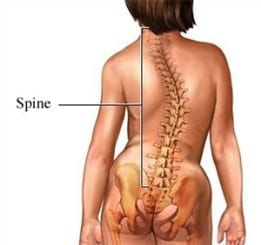
Scoliosis is defined as a sideways curvature of the spine. It is found in both children and adults, and increases in incidence in the geriatric population. Scoliosis may, bit does not necessarily have to cause pain in the patient. Although most cases are mild and do not cause pain, core stabilization exercises and postural awareness are critical in keeping the symptoms of scoliosis under control.
The Malady:
Scoliosis
The Facts:
Scoliosis is defined as a curvature in any part of the spine in excess of 10 degrees away from center. The curvature occurs in a side to side direction. While it is best visualized using x-rays, a significant curvature can be visible with the naked eye.
The Symptoms:
Patients with scoliosis will usually notice an asymmetry in their body when they look in the mirror. One side may be slightly shifted in one direction. A tell tale sign is by checking the “fat folds” on your sides. There is usually a small crease or indent in the fat on your sides, and it can appear asymmetrical if there is scoliosis present. Another way to tell is by running your fingers directly down the patient’s spine. If you can feel your finger “fall off” to the side suddenly and deviate off of a straight line, the patient may have scoliosis.
What is Happening:
In scoliosis, the spine shifts laterally and forms an “S” shape instead of going straight down. The muscles on either side of the vertebrae adjust to this new position, and may tighten up on one side. In severe cases, i.e. over 20 degrees if shift, the patient may have decreased lung capacity due to compression on the rib cage from the spinal bones.
Why Is This Happening:
There are three potential reasons for scoliosis. In congenital scoliosis, the patient is born with an improper alignment of the spine. An idiopathic scoliosis indicates that the cause for the scoliosis is unknown. However, it is classified by the age at which the symptoms were developed. This is by far the most common form, and can occur due to gradual changes in the body over time. The final type is secondary scoliosis, which occurs as a result of physical injury or disease process.
Lifestyle Adjustments:
Maintaining a good exercise regimen is critical in limiting the progression of your scoliosis. Because of the changes in the spine, it is important to keep your core muscles strong in order to maintain an upright posture. Constantly reminding yourself to ‘straighten up” and “pull your stomach muscles in” can help keep the curvatures from getting worse. It is also critical to wear backpacks instead of carrying pocketbooks on one side, as this can often make a scoliosis increase in intensity if you already have a slight curvature.
Fix It and Prevent It
Scoliosis often requires a thorough assessment by a physical therapist or physician to correct. It is important to identify which side of the spine is concave and which is convex, and devise exercise based off of this. Once this is done, unilateral exercises (strengthening only one side) can be initiated. Opening up the chest is also critical, as this will allow for improved posture and decreased compression of the lungs. Finally, maintaining a flat back and strong core will help engage the deep abdominal muscles that support the spine.
1) Pelvic tilts (20 reps 3 times a day)
2) scapular retractions one arm (10 reps 5 times a day)
3) Lay on foam roller lengthwise (5 mins a day)
